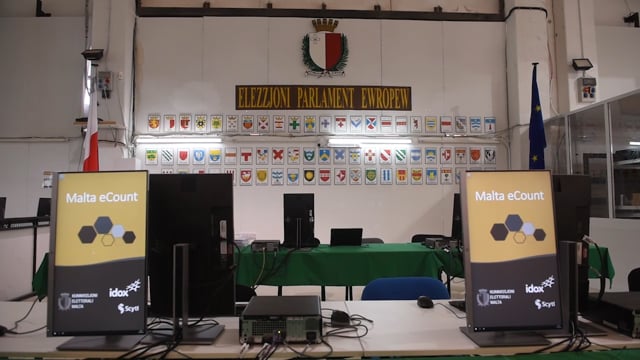[WATCH] Vote counting hall transformed as electronic system in place for European elections
The e-counting system aims to speed the process up and prevent human error


The vote counting hall in Naxxar has been transformed into one equipped with a fully-functional electronic system, which will be first used for the European Parliament and local council elections in May next year.
The new system will see the old manual method of counting votes ditched in favour of an automated e-Counting process, which will mean less time is taken for all votes to be counted, and the chance of human error is minimised.
E-counting will also be used for the general election and local council elections in 2024.

Chief Electoral Commissioner Joseph Church told the press, at an event showcasing the system, that two mock counts are planned to identify any teething troubles in the new system, one scheduled for Saturday, and the other for December. The latter will be a full-scale simulation of the counting process for the European elections.
While the way people vote is remaining the same - voters will still manually fill in a paper ballot sheet, with numbers indicating their preferred candidates - the votes will now be scanned and counted electronically.
The electronic system is being provided by IDOX, a Scotland-based company with over 23 years of experience in the sector. IDOX are partnering with Spanish firm Scytl, which is dealing with the security aspects of the counting.
IDOX regional manager Trevor Kirkup said the system is built to be accurate, secure, auditable, transparent, and provide results in a timely fashion.
“The counting engine’s accuracy has been proven through extensive testing,” he said, highlighting that 390,000 test ballots had been run through the system and scanned in less than six and a half hours.

Any votes which are scanned but detected by the system as being problematic - such as when a number isn't written clearly - will be sent to an adjudication section for verification. If the adjudicators cannot agree, the sheet is passed on to the hall’s Electoral Commission section, which will make a final decision.
Since it is not yet known how long the adjudication step will take, Kirkup said he couldn’t commit on the duration of the entire process for the counting of European election votes. “But we expect preliminary results to be out the same day as voting,” he said.
Asked what would happen to the old practice where party officials stationed behind the perspex used to count candidate votes to obtain a voting sample and call preliminary results, Kirkup said discussions where still ongoing with the political parties on the best way of integrating this with the new electronic methods.
A change in the familiar system
Votes from Malta’s 13 districts will still all be taken to the Naxxar counting hall, where they will be placed in a strong room to be verified. The ballot sheets will then go to their district sections, as used to happen traditionally.
After this, however, the electronic process will start, with the system being notified of how many ballot papers have been given to every individual district, so it knows how many to expect.
Every district has two scanners assigned to it - 26 in total. The ballot papers are placed in the scanners in clear view of everyone, and are each scanned. Once a full ballot box is scanned, it is marked as “closed” in the system.
This is followed by the “scan admin” stage, where all that has been scanned is checked. The ballot box afterwards goes to the electoral management team for verification, to ensure there is no difference between what was scanned and what was in the ballot box.
Any ballot papers with which there was some are sent over for human adjudication - there is no auto-rejection by the system in place. The adjudicators will all have a screen which will highlight which problems were found with the ballot paper.
All valid ballot papers which have been scanned will be displayed on large screens facing the perspex, clearly indicating the preference numbers.
Once the adjudication process is finished, if all officials are happy, a preliminary count will be held and the result can then be called.
In order for the scanners to more accurately read the ballot sheets, some changes were made to the papers themselves, including increasing their weight to 90gsm. Each candidate will now also have a small photo of themselves next to their names on the paper.


.jpeg)



.jpg)










.png)





